A Compact Filtering Coupler with Unwanted Harmonic Rejection Using LC Composite Lines for Communication Systems Applications
Abstract
1. Introduction
2. Design Process
2.1. Typical 800 MHz Coupler
2.2. Proposed Coupler
3. Proposed FBLC Analysis
4. Simulations
5. Fabrication
6. Conclusions
Author Contributions
Funding
Data Availability Statement
Conflicts of Interest
References
- Pednekar, P.H.; Hallberg, W.; Fager, C.; Barton, T.W. Analysis and design of a Doherty-like RF-input load modulated balanced amplifier. IEEE Trans. Microw. Theory Tech. 2018, 66, 5322–5335. [Google Scholar] [CrossRef]
- Nikandish, G.; Staszewski, R.B.; Zhu, A. Breaking the bandwidth limit: A review of broadband Doherty power amplifier design for 5G. IEEE Microw. Mag. 2020, 21, 57–75. [Google Scholar] [CrossRef]
- Faten, A.C. Optical design of dilute nitride quantum wells vertical cavity semiconductor optical amplifiers for communication systems. ARO-Sci. J. Koya Univ. 2016, 4, 8–12. [Google Scholar]
- Koziel, S.; Bekasiewicz, A. Fast surrogate-assisted frequency scaling of planar antennas with circular polarisation. IET Microw. Antennas Propag. 2019, 13, 602–607. [Google Scholar] [CrossRef]
- Yahya, S.I. Anticipated Impact of In-Car Mobile Calls on the Electromagnetic Interaction of Handset Antenna and Human. ARO-Sci. J. Koya Univ. 2014, 2, 1–10. [Google Scholar]
- Venter, J.J.; Stander, T.; Ferrari, P. $ X $-Band Reflection-Type Phase Shifters Using Coupled-Line Couplers on Single-Layer RF PCB. IEEE Microw. Wirel. Compon. Lett. 2018, 28, 807–809. [Google Scholar] [CrossRef]
- Wang, X.; Yin, W.-Y.; Wu, K.-L. A dual-band coupled-line coupler with an arbitrary coupling coefficient. IEEE Trans. Microw. Theory Tech. 2012, 60, 945–951. [Google Scholar] [CrossRef]
- Martel, J.; Fernández-Prieto, A.; del Río, J.L.M.; Martín, F.; Medina, F. Design of a differential coupled-line directional coupler using a double-side coplanar waveguide structure with common-signal suppression. IEEE Trans. Microw. Theory Tech. 2020, 69, 1273–1281. [Google Scholar] [CrossRef]
- Parandin, F.; Sheykhian, A.; Bagheri, N. A Novel Design for an Ultracompact Optical Majority Gate Based on Ring Resonator on Photonic Crystals Substrate. J. Comput. Electron. 2022; under review. [Google Scholar] [CrossRef]
- Hosseini, S.M.; Rezaei, A. Design of a Branch-line Microstrip Coupler Using Spirals and Step Impedance Cells for WiMAX Applications. Aro-Sci. J. Koya Univ. 2020, 8, 1–4. [Google Scholar] [CrossRef]
- Rezaei, A.; Yahya, S.I. High-performance ultra-compact dual-band bandpass filter for global system for mobile communication-850/global system for mobile communication-1900 applications. ARO-Sci. J. Koya Univ. 2019, 7, 34–37. [Google Scholar] [CrossRef]
- Yahya, S.I.; Rezaei, A.; Khaleel, Y.A. Design and Analysis of a Wide Stopband Microstrip Dual-band Bandpass Filter. ARO-Sci. J. Koya Univ. 2021, 9, 83–90. [Google Scholar] [CrossRef]
- Yahya, S.I.; Rezaei, A. An Area-efficient Microstrip Diplexer with a Novel Structure and Low Group Delay for Microwave Wireless Applications. ARO-Sci. J. Koya Univ. 2020, 8, 71–77. [Google Scholar] [CrossRef]
- Hosseinkhani, F.; Roshani, S. A compact branch-line coupler design using low-pass resonators and meandered lines open stubs. Turk. J. Electr. Eng. Comput. Sci. 2018, 26, 1164–1170. [Google Scholar]
- Lalbakhsh, A.; Mohamadpour, G.; Roshani, S.; Ami, M.; Roshani, S.; Sayem, A.S.M.; Alibakhshikenari, M.; Koziel, S. Design of a compact planar transmission line for miniaturized rat-race coupler with harmonics suppression. IEEE Access 2021, 9, 129207–129217. [Google Scholar] [CrossRef]
- Xia, L.; Li, J.-L.; Twumasi, B.A.; Liu, P.; Gao, S.-S. Planar dual-band branch-line coupler with large frequency ratio. IEEE Access 2020, 8, 33188–33195. [Google Scholar] [CrossRef]
- Jung, S.-C.; Negra, R.; Ghannouchi, F.M. A design methodology for miniaturized 3-dB branch-line hybrid couplers using distributed capacitors printed in the inner area. IEEE Trans. Microw. Theory Tech. 2008, 56, 2950–2953. [Google Scholar] [CrossRef]
- Jamshidi, M.B.; Roshani, S.; Talla, J.; Mohammadi, M.S.; Roshani, S.; Peroutka, Z. A Modified Branch Line Coupler with Ultra-Wide Harmonics Rejection Using Resonators and Open-Ended Stubs. In Proceedings of the 2021 IEEE 12th Annual Ubiquitous Computing, Electronics & Mobile Communication Conference (UEMCON), New York, NY, USA, 1–4 December 2021; pp. 0860–0865. [Google Scholar]
- Shen, D.; Wang, K.; Zhang, X. A substrate integrated gap waveguide based wideband 3-dB coupler for 5G applications. IEEE Access 2018, 6, 66798–66806. [Google Scholar] [CrossRef]
- Askarian, A.; Parandin, F. A novel proposal for all optical 1-bit comparator based on 2D linear photonic crystal. J. Comput. Electron. 2022, 1–8. [Google Scholar] [CrossRef]
- Lalbakhsh, A.; Parandin, F.; Parandin, F.; Kamarian, R.; Jomour, M.; Alibakhshikenari, M. Ultra-compact photonic crystal based all optical half adder. In 2021 Photonics & Electromagnetics Research Symposium (PIERS); IEEE: Hangzhou, China, 2021. [Google Scholar]
- Parandin, F.; Heidari, F.; Rahimi, Z.; Olyaee, S. Two-Dimensional photonic crystal Biosensors: A review. Opt. Laser Technol. 2021, 144, 107397. [Google Scholar] [CrossRef]
- Parandin, F.; Kamarian, R.; Jomour, M. A novel design of all optical half-subtractor using a square lattice photonic crystals. Opt. Quantum Electron. 2021, 53, 114. [Google Scholar] [CrossRef]
- Karkhanehchi, M.M.; Parandin, F.; Zahedi, A. Design of an all optical half-adder based on 2D photonic crystals. Photonic Netw. Commun. 2017, 33, 159–165. [Google Scholar] [CrossRef]
- Parandin, F. Ultra-Compact and Low Delay Time All Optical Half Adder Based on Photonic Crystals. Opt. Quantum Electron. 2021, 60, 2275–2280. [Google Scholar]
- Alanazi, A.K.; Alizadeh, S.M.; Nurgalieva, K.S.; Nesic, S.; Grimaldo Guerrero, J.W.; Abo-Dief, H.M.; Eftekhari-Zadeh, E.; Nazemi, E.; Narozhnyy, I.M. Application of neural network and time-domain feature extraction techniques for determining volumetric percentages and the type of two phase flow regimes independent of scale layer thickness. Appl. Sci. 2022, 12, 1336. [Google Scholar] [CrossRef]
- Nazemi, E.; Roshani, G.; Feghhi, S.; Setayeshi, S.; Zadeh, E.E.; Fatehi, A. Optimization of a method for identifying the flow regime and measuring void fraction in a broad beam gamma-ray attenuation technique. Int. J. Hydrog. Energy 2016, 41, 7438–7444. [Google Scholar] [CrossRef]
- Roshani, G.; Nazemi, E.; Roshani, M. Intelligent recognition of gas-oil-water three-phase flow regime and determination of volume fraction using radial basis function. Flow Meas. Instrum. 2017, 54, 39–45. [Google Scholar] [CrossRef]
- Hosseini, S.; Taylan, O.; Abusurrah, M.; Akilan, T.; Nazemi, E.; Eftekhari-Zadeh, E.; Bano, F.; Roshani, G.H. Application of Wavelet Feature Extraction and Artificial Neural Networks for Improving the Performance of Gas–Liquid Two-Phase Flow Meters Used in Oil and Petrochemical Industries. Polymers 2021, 13, 3647. [Google Scholar] [CrossRef]
- Nazemi, E.; Feghhi, S.; Roshani, G.; Peyvandi, R.G.; Setayeshi, S. Precise void fraction measurement in two-phase flows independent of the flow regime using gamma-ray attenuation. Nucl. Eng. Technol. 2016, 48, 64–71. [Google Scholar] [CrossRef]
- Roshani, G.H.; Roshani, S.; Nazemi, E.; Roshani, S. Online measuring density of oil products in annular regime of gas-liquid two phase flows. Measurement 2018, 129, 296–301. [Google Scholar] [CrossRef]
- Roshani, G.; Hanus, R.; Khazaei, A.; Zych, M.; Nazemi, E.; Mosorov, V. Density and velocity determination for single-phase flow based on radiotracer technique and neural networks. Flow Meas. Instrum. 2018, 61, 9–14. [Google Scholar] [CrossRef]
- Roshani, S.; Azizian, J.; Roshani, S.; Jamshidi, M.B.; Parandin, F. Design of a miniaturized branch line microstrip coupler with a simple structure using artificial neural network. Frequenz 2022, 76, 255–263. [Google Scholar] [CrossRef]
- Liu, A.; Leng, M.; Pan, G.; Yu, M. Automatic Coupler Design Based on Artificial Neural Network with Self-Adaptive Local Surrogates. IEEE Trans. Microw. Theory Tech. 2022, 70, 4711–4725. [Google Scholar] [CrossRef]
- Parandin, F.; Reza Malmir, M. Reconfigurable all optical half adder and optical XOR and AND logic gates based on 2D photonic crystals. Opt. Quantum Electron. 2020, 52, 56. [Google Scholar] [CrossRef]
- Jamshidi, M.B.; Lalbakhsh, A.; Mohamadzade, B.; Siahkamari, H.; Mousavi, S.M.H. A novel neural-based approach for design of microstrip filters. AEU Int. J. Electron. Commun. 2019, 110, 152847. [Google Scholar] [CrossRef]
- Jamshidi, M.; Lalbakhsh, A.; Lotfi, S.; Siahkamari, H.; Mohamadzade, B.; Jalilian, J. A neuro-based approach to designing a Wilkinson power divider. Int. J. RF Microw. Comput. Aided Eng. 2020, 30, e22091. [Google Scholar] [CrossRef]
- Yahya, S.I.; Alameri, B.M.; Jamshidi, M.B.; Roshani, S.; Chaudhary, M.A.; Ijemaru, G.K.; Mezaal, Y.S.; Roshani, S. A New Design Method for Class-E Power Amplifiers Using Artificial Intelligence Modeling for Wireless Power Transfer Applications. Electronics 2022, 11, 3608. [Google Scholar] [CrossRef]
- Jamshidi, M.B.; Roshani, S.; Talla, J.; Roshani, S.; Peroutka, Z. Size reduction and performance improvement of a microstrip Wilkinson power divider using a hybrid design technique. Sci. Rep. 2021, 11, 7773. [Google Scholar] [CrossRef]
- Du, R.-N.; Weng, Z.-B.; Zhang, C. A miniaturized filtering 3-dB branch-line hybrid coupler with wide suppression band. Prog. Electromagn. Res. Lett. 2018, 73, 83–89. [Google Scholar] [CrossRef]
- Fardin, E.; Holland, A.; Ghorbani, K. Electronically tunable lumped element 90$^{circ} $ hybrid coupler. Electron. Lett. 2006, 42, 353–355. [Google Scholar] [CrossRef]
- Beigizadeh, M.; Dehghani, R.; Nabavi, A. Analysis and design of a lumped-element hybrid coupler using limited quality factor of components. AEU Int. J. Electron. Commun. 2017, 82, 312–320. [Google Scholar] [CrossRef]
- Abd El-Hameed, A.S.; Barakat, A.; Abdel-Rahman, A.B.; Allam, A. Design of low-loss coplanar transmission lines using distributed loading for millimeter-wave power divider/combiner applications in 0.18-µ m CMOS technology. IEEE Trans. Microw. Theory Tech. 2018, 66, 5221–5229. [Google Scholar] [CrossRef]
- Pozar, D.M. Microwave Engineering; John Wiley & Sons: Hoboken, NJ, USA, 2011. [Google Scholar]
- Zhang, F. Miniaturized and harmonics-rejected slow-wave branch-line coupler based on microstrip electromagnetic bandgap element. Microw. Opt. Technol. Lett. 2009, 51, 1080–1084. [Google Scholar] [CrossRef]
- Wang, J.; Wang, B.-Z.; Guo, Y.-X.; Ong, L.; Xiao, S. A compact slow-wave microstrip branch-line coupler with high performance. IEEE Microw. Wirel. Compon. Lett. 2007, 17, 501–503. [Google Scholar] [CrossRef]
- Lu, K.; Wang, G.-M.; Zhang, C.-X.; Wang, Y.-W. Design of miniaturized branch-line coupler based on novel spiral-based resonators. J. Electromagn. Waves Appl. 2011, 25, 2244–2253. [Google Scholar] [CrossRef]
- Tsai, K.-Y.; Yang, H.-S.; Chen, J.-H.; Chen, Y.-J.E. A miniaturized 3 dB branch-line hybrid coupler with harmonics suppression. IEEE Microw. Wirel. Compon. Lett. 2011, 21, 537–539. [Google Scholar] [CrossRef]
- Roshani, S.; Roshani, S. A compact coupler design using meandered line compact microstrip resonant cell (MLCMRC) and bended lines. Wirel. Netw. 2021, 27, 677–684. [Google Scholar] [CrossRef]
- He, J.; Wang, B.-Z.; Shao, W.; Xiao, S.-Q. A Compact Microstrip Branch-Line Coupler with Capacitor Loading. In Proceedings of the 2008 IEEE MTT-S International Microwave Workshop Series on Art of Miniaturizing RF and Microwave Passive Components, Chengdu, China, 14–15 December 2008; pp. 139–141. [Google Scholar]
- Roshani, S.; Yahya, S.I.; Roshani, S.; Rostami, M. Design and fabrication of a compact branch-line coupler using resonators with wide harmonics suppression band. Electronics 2022, 11, 793. [Google Scholar] [CrossRef]
- Honari, M.M.; Mirzavand, R.; Mousavi, P.; Abdipour, A. Class of miniaturised/arbitrary power division ratio couplers with improved design flexibility. IET Microw. Antennas Propag. 2015, 9, 1066–1073. [Google Scholar] [CrossRef]
- Kim, J.-S.; Kong, K.-B. Compact branch-line coupler for harmonic suppression. Prog. Electromagn. Res. C 2010, 16, 233–239. [Google Scholar] [CrossRef]
- Gu, J.; Sun, X. Miniaturization and harmonic suppression rat-race coupler using C-SCMRC resonators with distributive equivalent circuit. IEEE Microw. Wirel. Compon. Lett. 2005, 15, 880–882. [Google Scholar]
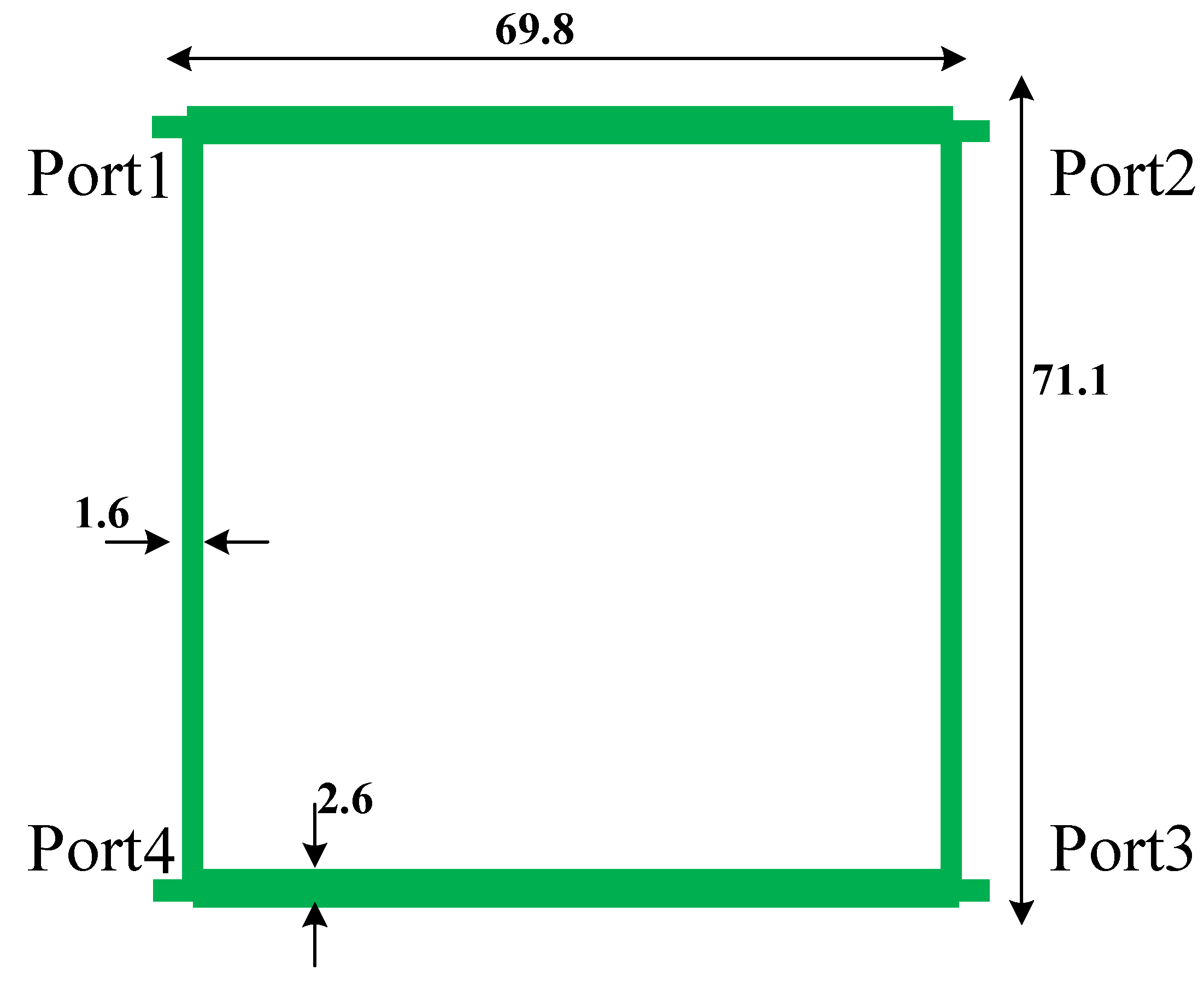
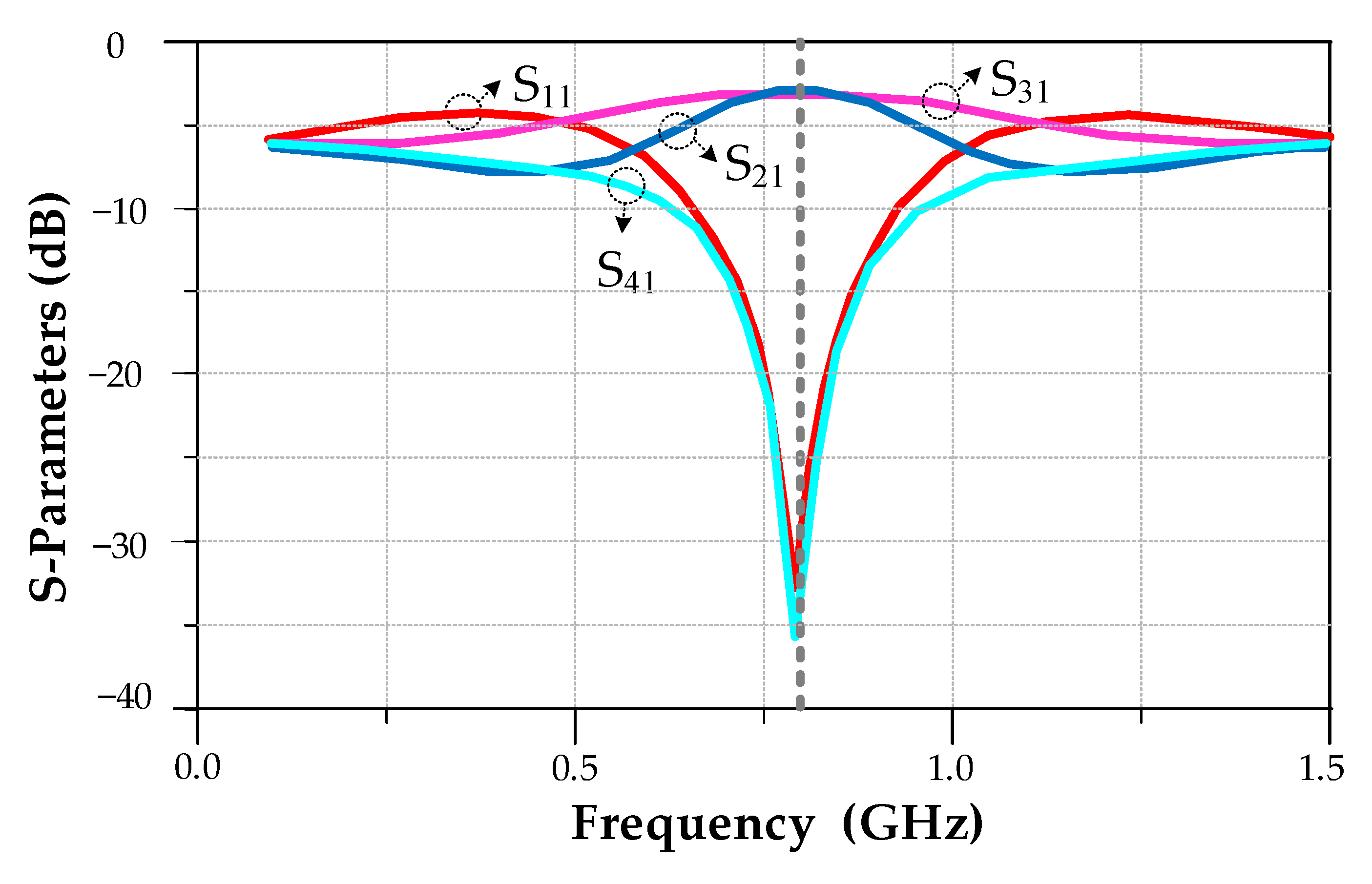

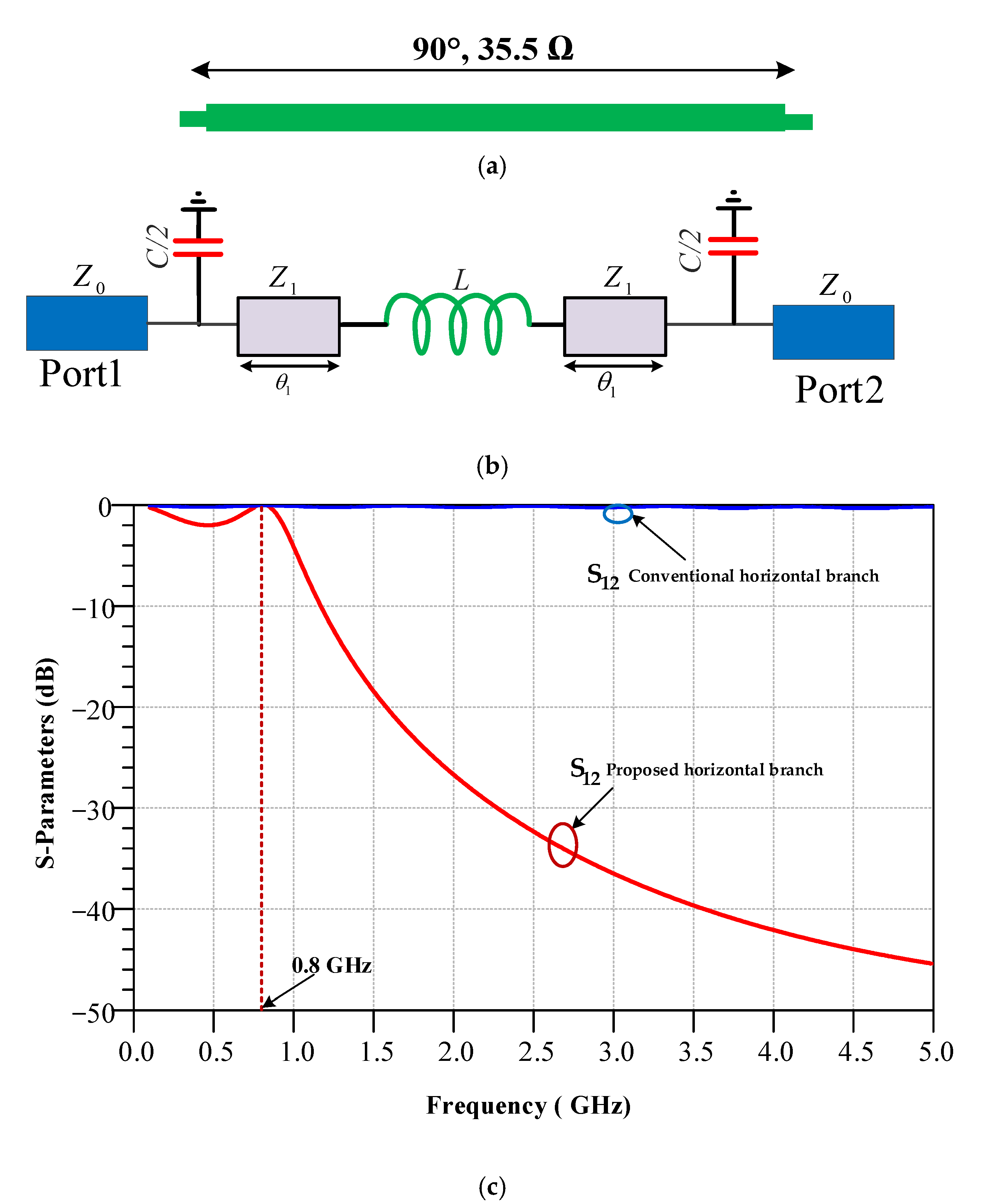
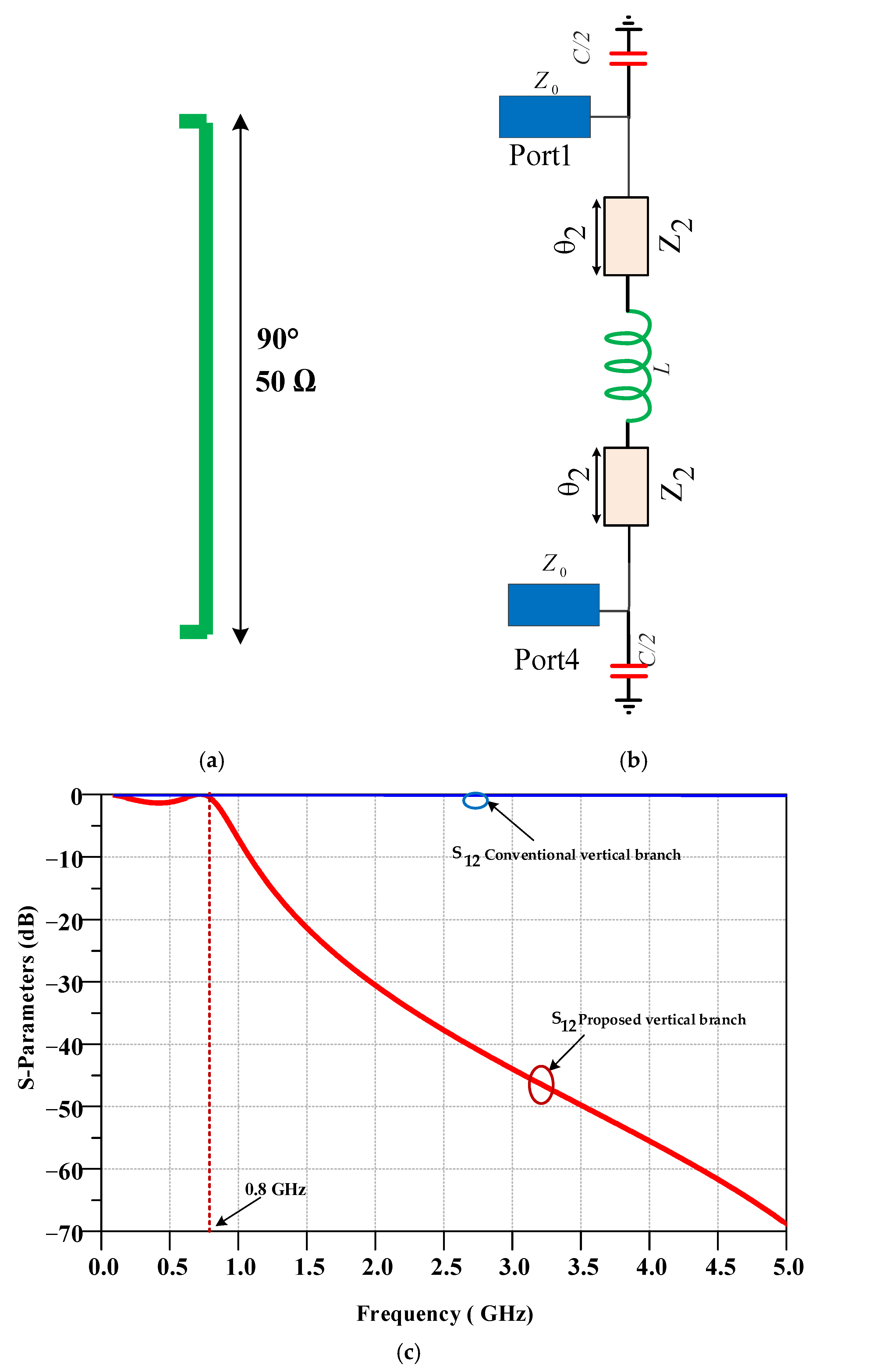


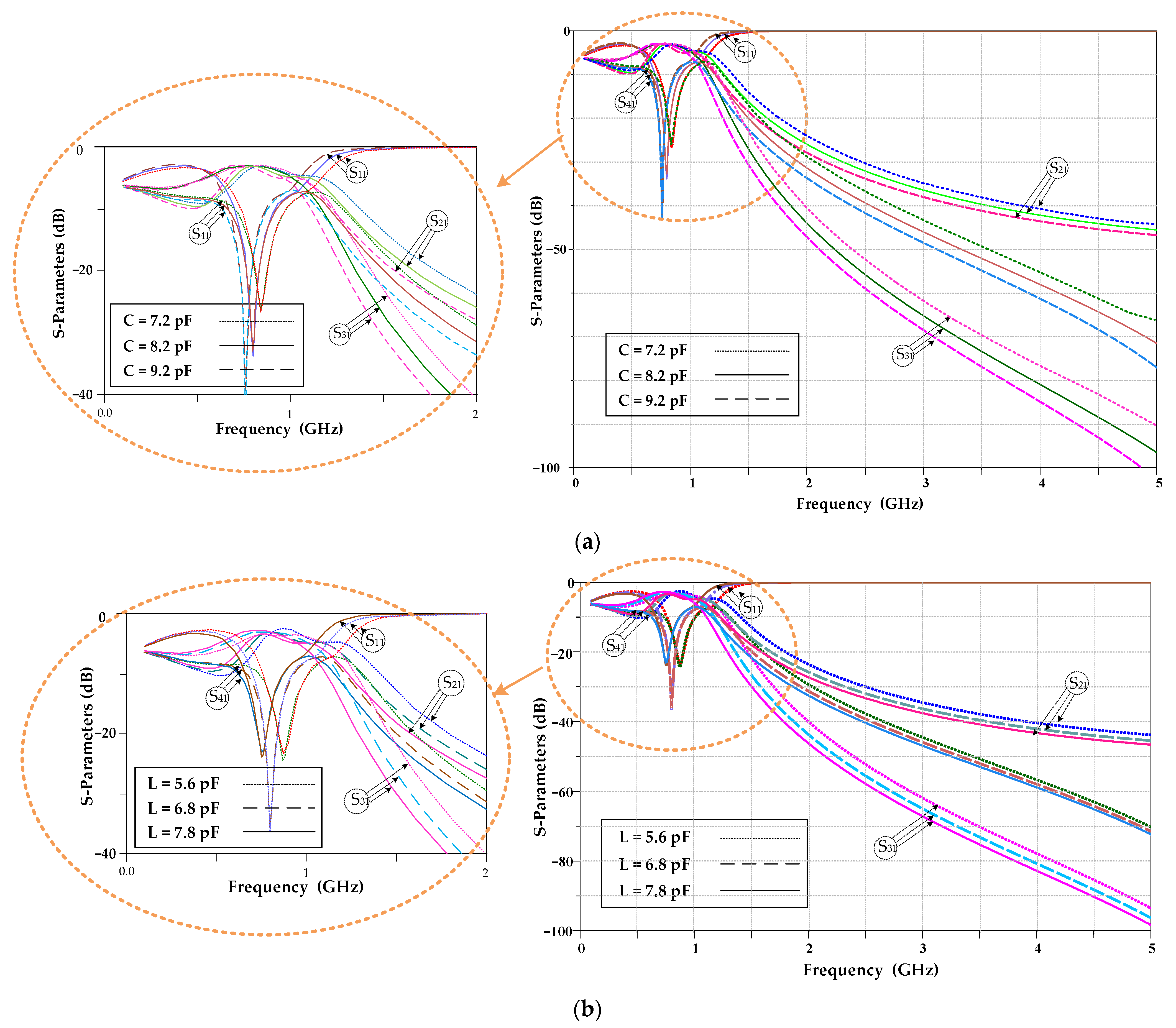


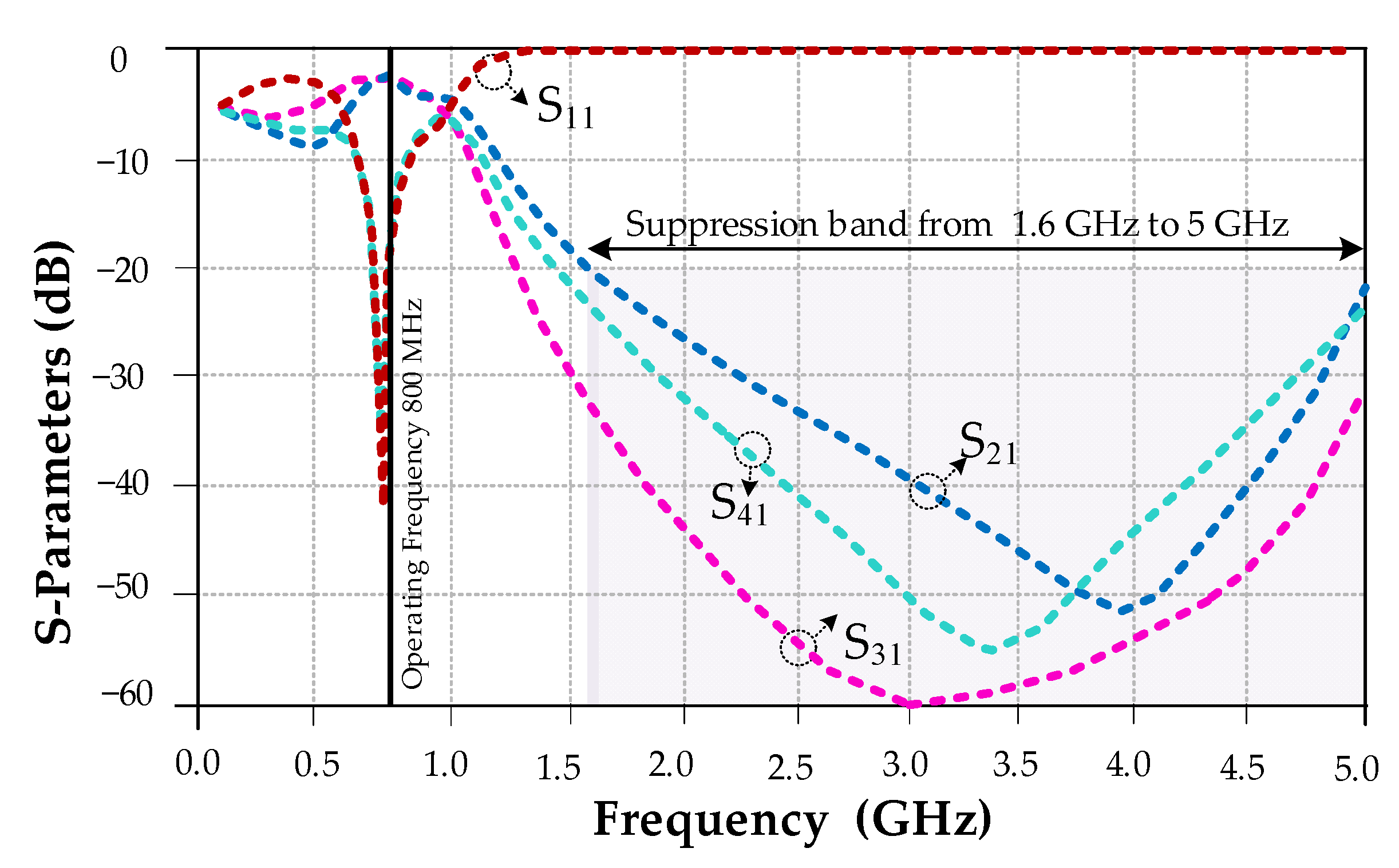
| L | C | Z1 | θ1 | Z2 | θ2 |
|---|---|---|---|---|---|
| 6 nH | 5.2 pF | 10 Ω | 15° | 161 Ω | 5° |
| Ref. | Operating Frequency (MHz) | Size Reduction | Harmonics Suppression |
|---|---|---|---|
| [45] | 2400 | 55% | - |
| [46] | 2000 | 72% | 2nd and 3rd |
| [33] | 1800 | 66% | 2nd |
| [47] | 1350 | 64% | 2nd and 3rd |
| [48] | 1160 | 55% | - |
| [49] | 900 | 64% | 3rd and 5th |
| [50] | 835 | 73% | 2nd |
| [51] | 750 | 84% | 2nd–7th |
| [52] | 1000 | 73% | 2nd |
| [15] | 1800 | 74% | 2nd–7th |
| [53] | 1000 | 63% | 2nd and 3rd |
| [54] | 2400 | 55% | 2nd and 3rd |
| This work | 800 | 87% | 2nd–6th |
Disclaimer/Publisher’s Note: The statements, opinions and data contained in all publications are solely those of the individual author(s) and contributor(s) and not of MDPI and/or the editor(s). MDPI and/or the editor(s) disclaim responsibility for any injury to people or property resulting from any ideas, methods, instructions or products referred to in the content. |
© 2022 by the authors. Licensee MDPI, Basel, Switzerland. This article is an open access article distributed under the terms and conditions of the Creative Commons Attribution (CC BY) license (https://creativecommons.org/licenses/by/4.0/).
Share and Cite
Roshani, S.; Yahya, S.I.; Mezaal, Y.S.; Chaudhary, M.A.; Al-Hilali, A.A.; Ghadi, Y.Y.; Karimi, M.; Roshani, S. A Compact Filtering Coupler with Unwanted Harmonic Rejection Using LC Composite Lines for Communication Systems Applications. Systems 2023, 11, 14. https://doi.org/10.3390/systems11010014
Roshani S, Yahya SI, Mezaal YS, Chaudhary MA, Al-Hilali AA, Ghadi YY, Karimi M, Roshani S. A Compact Filtering Coupler with Unwanted Harmonic Rejection Using LC Composite Lines for Communication Systems Applications. Systems. 2023; 11(1):14. https://doi.org/10.3390/systems11010014
Chicago/Turabian StyleRoshani, Saeed, Salah I. Yahya, Yaqeen Sabah Mezaal, Muhammad Akmal Chaudhary, Aqeel A. Al-Hilali, Yazeed Yasin Ghadi, Mohsen Karimi, and Sobhan Roshani. 2023. "A Compact Filtering Coupler with Unwanted Harmonic Rejection Using LC Composite Lines for Communication Systems Applications" Systems 11, no. 1: 14. https://doi.org/10.3390/systems11010014
APA StyleRoshani, S., Yahya, S. I., Mezaal, Y. S., Chaudhary, M. A., Al-Hilali, A. A., Ghadi, Y. Y., Karimi, M., & Roshani, S. (2023). A Compact Filtering Coupler with Unwanted Harmonic Rejection Using LC Composite Lines for Communication Systems Applications. Systems, 11(1), 14. https://doi.org/10.3390/systems11010014









